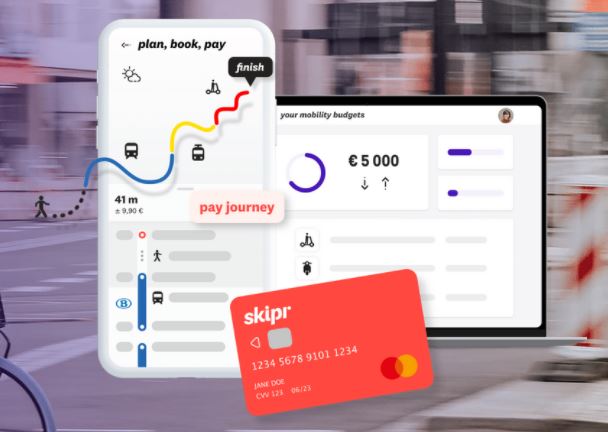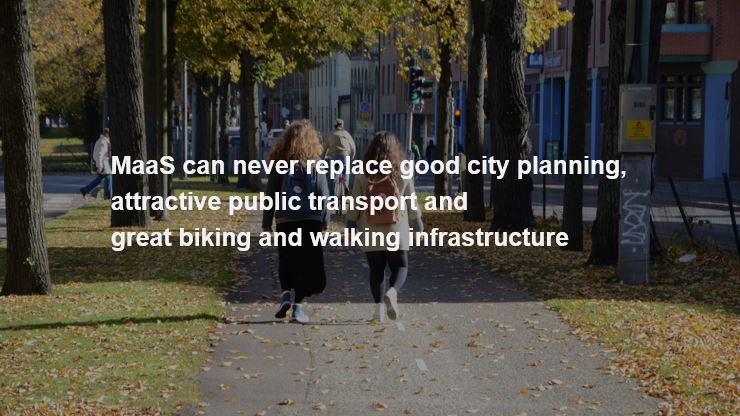💡 Maas / Part 2 – business models, technologies and territories
💡 Maas / Part 2 – business models, technologies and territories
by Joëlle Touré, delegate general, Futura-Mobility
On 9 & 10 March 2021, Futura-Mobility organised a session over two mornings dedicated to Mobility as a Service (MaaS).
After kicking off to great fanfare in 2015-2018, together with big promises and a great many expectations, MaaS is today facing reality. So now the time is ripe to take stock of the concept and explore some key questions: what business models for MaaS services? What about regional and national expansion of MaaS?
MaaS seeks business model
“Finding business models is really complex,” declares Olivier Vacheret, department head, Information & Digital Services, Ile-de-France Mobilités (IdFM). “For us, the business model lies in promoting environmental and changing mobility behaviour objectives.”
“We are seeing pivoting among some players that started out with business models directly targeting end users (B2C), but are now shifting towards B2B (business to business) or B2G2C (business to government to citizen) models,” points out Maxime Audouin, research author on the topic of governance when introducing MaaS systems in Europe, Helsinki and Vienna in particular. “Ultimately, difficulties with the business model of the Mobility as a Service paradigm highlight the need to move towards a new paradigm: Mobility as a (Public) Service.”
This is precisely the case for Trafi and Skipr. Both companies started out with a B2C model before pivoting – the former to a B2G2C and positioning itself as a software publisher, based on the Software as a Service (SaaS) model rolling out white label products; the latter to a B2B2C model targeting firms and their employees.
Discussing this shift to B2G2C, David Lainé, director France, Belgium & Southern Europe, Trafi, explains how “at Trafi we think MaaS should be governed and steered by public authorities given their central role in steering mobility across the territory, investing in infrastructure (…), and applying mobility policy on its territory.”
Offering software already developed and continuously updated “means solutions can be launched in record time,” because Trafi’s software product is simply adapted to the local context (business models, integrating operators, route planner settings depending on the mobility policy, together with branding, icons, colour codes…) rather than built from a blank page. To mention just a few examples of ongoing development that can benefit Public Transport Authorities (PTA) using the Trafi software (by activating an app update): “the multimodal subscription in Switzerland (…) or the mobility wallet in Berlin, which allows firms on the territory to allocate mobility budget (forfait mobilité durable, FMD) to employees to be consumed in the MaaS application for the territory.” Furthermore, since this continuous development is included in the Trafi licence it is not funded by any of the software clients.
In Berlin, for instance, the Jelbi app was launched “in six months.” It includes nine operators, has 250,000 customers actively using two thirds public transport and one third shared transport, and is rated 4.7 out of 5 by customers.

Skipr, presented by founder Mathieu de Lophem, soon turned to the B2B model “to help companies bring about mobility change towards more sustainable options among employees.” The product was developed in early 2019 in Belgium. The start-up already has 80 business clients, both large and small, in Belgium and France, with an extremely high usage rate – since 80% of employees use Skipr for all travel. Says Mr de Lophem: “the gamechanger for us was realising you need to offer a carrot to encourage change in mobility behaviour” – the carrot in Belgium being the ‘mobility budget’ and in France the ‘sustainable mobility allowance’ (forfait mobilité durable, FMD).
Right from day one, the MaaS base solution built by Skipr aimed to integrate all the MaaS building blocks, from route planner to payment and ticketing support. Today, like for Trafi, Skipr describes itself as a “mobility SaaS (Software as a Service) provider whose Maas app represents one part of its offer, boosted by a payment card dedicated to mobility and a management platform for the business client to handle all this mobility.”
The payment card is for loading employee credit for travel across Europe and to prevent misuse from the start by including the company rules, such as forbidding ride-hailing, for instance. Mathieu de Lophem’s goal is “to go a considerable way towards simplifying paperwork for employers” – be it through upstream control, with tools for calculating carbon missions or options for exporting data or reallocating credit.

For Skipr, a key mission is “preaching” so companies fully understand the point of using government incentives like the ‘mobility budget’ and ‘sustainable mobility allowance’. At the same time, Mr de Lophem and his team are fully aware big firms will need Skipr to develop custom tools while smaller sized business will request relatively standard tools.
Skipr’s solution could serve PTAs within their own app to reach employees on their territories, or large service providers, like lunch voucher group Edenred for instance.
From the PTA side, IdFM, in addition to the B2C solution offered with its own app iledefrancemobilités, is also developing a B2B component to “offer services and data reflecting good mobility practice,” says Mr Vacheret, either via a dedicated app or that of partners, through an extremely open partnership approach. The French LOM legislation (loi d’orientation des mobilités, 2019) is certainly making this B2B move easier, by “making it possible to start thinking about new pricing terms and conditions, especially integration of the Forfait Mobilité Durable for companies,” reckons Laura Papet, associate director, PMP Conseil. For instance, “in Grenoble, with the Passe Mobilité [travelcard], we are currently discussing with employers to establish adequate value propositions since, at the end of the day, most of the targets are people working for big firms on the territory. (…) You could say it’s a G2B approach.”
Traditional public transport operators, like Keolis, are evolving. “We are becoming a mobility integrator. The idea is to accompany the PTA in integrating the different offers. It’s not only about having a digital tool, but having the conditions underlying offers integrated too,” points out Julie Sulli, head of transversal marketing projects, Keolis. In Dijon, the métropole (French administrative entity) has entrusted Keolis with running all the mobility services including parking, the car pound, and bikes – so not only those under public service delegation contract.
Says Olivier Vacheret from IdFM, “the innovation ecoystem around MaaS is flourishing, despite the technologies and governance being quite unstable, and even for different types of mobility we haven’t yet fully explored. So it’s important to make room for innovation since this is what will drive our ability to find solutions tomorrow.”
Michel Gruber, MaaS director at e.Voyageurs SNCF, illustrates this point with the introduction – in partnership with IdFM – of NFC (contactless) technology to the Assistant SNCF app. This new technology means customers can have completely paperless tickets on their phones, and renew subscriptions by phone too.”

Technology, but not only
Avoid approaching MaaS too much from the tool angle! MaaS sublimates all the ways of integrating transport services in physical form that are a prerequisite for digital integration,” states Maxime Audouin. As Olivier Vacheret from IdFM says, “there’s no MaaS if we don’t put physical infrastructure and mobility offers out there. This might seem obvious but in the value chain it’s important not to forget these things.” Also commenting, Ms Sulli from Keolis points out how seamless must be part of the app, “and also part of its action on the ground!”

On the end-user side, digital is just one building brick in a customer interface ecosystem that also includes call platforms, physical stores for supporting locals and visitors with their mobility,” adds Ms Papet. Dijon, for instance, has worked on its customer relations approach across the entire mobility spectrum, including the car pound and off-street parking, in line with what is being done for public transport.
Not to be overlooked, “pricing integration is a real issue – so combinations of incentive pricing – to encourage use of different modes with payment methods ranging from the classic subscription to occasional travel, open payment, post-payment…. The challenge is offering customers different services and pricing options,” points out Julie Sulli from Keolis. Lille Métropole, for instance, has worked with Keolis on pricing integration for its territory, TER regional train services in particular.
Besides, “when we want to integrate booking services, these services must already be digitised with their operators and the data on a common repository!” comments Maxime Audouin. He believes this difficulty is partly why MaaS tools are taking so long to roll out, especially in France. Indeed, Mathieu de Lophem from Skipr is well aware of this barrier: “if the public transport operator payment isn’t on an app, we can’t offer other paid mobility solutions on our app because public transport has such a structuring effect this actually limits us. Such is the case with Ile-de-France right now.”
From this angle, the Covid-19 crisis has certainly accelerated digitisation. “In 2020, among the networks in France operated by Keolis, the number that digitised on-board ticket sales has doubled, much faster than anticipated,” remarks Ms Sulli from Keolis.
Michel Gruber explains for his part how Assistant SNCF is aiming for “full integration, in other words, having the whole service inside the app: information, reservations, tickets,” without the customer being transferred to other apps.
Standardisation will also encourage MaaS. For this, “discussions are underway at both European and French levels,” points out Laurent Chevereau, MaaS project director, CEREMA. Standardisation “should in the long run lead to lower integration costs and bring MaaS systems to medium-sized towns and less dense territories.”
Technology for territorial expansion?
“There is the question of access and equality, both social and territorial, of a relevant mobility offer, which raises questions over pricing and the offers serving all territories.” Referencing Aix Marseille Provence Métropole, Laura Papet, associate director at PMP Conseil, also highlights “the urgent need to exchange with other métropoles and territories in order to start establishing standards, not only technical, but first and foremost standards for trials and testing agreements with third parties, discussions on managing the revenue, which is mixed public and private.”
As shared by Julie Sulli, Keolis is convinced “MaaS must be an inclusive, accessible digital service, to reach as many people as possible (…) since ultimately, this is how MaaS will achieve modal shift objectives over the long term.” Consequently, Keolis is developing offers like guidance, mobility assistant, voice assistant, with personalised recommendations, so people can switch to more sustainable mobility.
In France, mobility policy is shared between urban territories and Régions (State administrative districts), each with its own governance. Mr Lainé from Trafi advocates for pooling and interoperability of MaaS between these entities. This is the model used by Trafi between Berlin and Munich today. The company provides a pooled data platform and journey planner, together with an integration platform for pooling payment, purchasing, the user account, the PSPs (Payment Service Providers) – which, moreover, do discounts depending on the volume of transactions. “Several user interfaces can be plugged into these building bricks: the Région MaaS – so that small communities can access a MaaS service – as well as the MaaS for large urban territories or métropoles,” he explains.
Furthermore, roaming technology between apps “is mostly likely the future of MaaS,” he points out. This technology means inhabitants of a big city, like Berlin for instance, can go to Munich and travel around the city all the while remaining on their original Berlin app.
For Assistant SNCF, the outlook is similar to that presented by Mr Lainé. Recently, the Assistant SNCF mobility offer opened up to include selling the transport tickets of medium- and average-sized towns. “The aim is to not only be present in major hubs or mobility flows but for the app to span whole territory and link up all the different types of mobility,” explains Michel Gruber. Without competing with the MaaS projects of the different PTAs, the idea is for Assistant SNCF to serve as a relay on a national level, given the size of its audience (the app has over 16 million downloads).
“We are capable of bringing the public policies of local authorities to our customers,” says Mr Gruber. The technology bricks developed in the app are offered on the market to local authorities so they themselves can integrate them into their MaaS, ultimately in SaaS mode.
Cover photo: StockSnap – Pixabay


